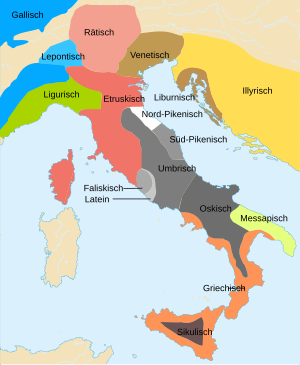Rhaetian language
| Rhaetian (†) | ||
|---|---|---|
| Period | until 3rd century AD | |
|
Formerly spoken in |
Alps (and foothills) north of the line from Como to Verona : Veneto, Trentino, Graubünden, South Tyrol, Tyrol, Vorarlberg, Upper Bavaria | |
| Language codes | ||
| ISO 639 -1 |
- |
|
| ISO 639 -2 |
- |
|
| ISO 639-3 |
xrr |
|
The Rhaetian language was spoken in the central Alpine region until the 3rd century AD , especially in northeastern Italy (including today's South Tyrol ) and in today's Austria ( Tyrol and Vorarlberg ), but also in today's eastern Switzerland and possibly other neighboring areas . It is attested in numerous, albeit consistently very short, inscriptions and was written in various alphabets belonging to the ancient Italian group of writings. All inscriptions are systematically recorded in the Thesaurus Inscriptionum Raeticarum (TIR) of the University of Vienna and are accessible online.
Because of a certain vagueness of the term Raeter , some statements are problematic here; this even applies to the assumption that the Raetians used the Raetian language .
Genealogical classification
With regard to their genealogical classification, several strongly diverging theories have emerged in modern times:
- Classification as an isolated language .
- The classification in a group with the Etruscan language and the Lemnian language in an otherwise isolated language group of the so-called Aegean or Tyrsenic languages . The Indo-Europeanist and Etruscanologist Helmut Rix lists a number of similarities between Rhaetian and Etruscan, especially in the area of grammar. At the turn of the ages, the Roman historians Pliny the Elder , Pompeius Trogus and Titus Livius believed that the Rhaetians had been Etruscans expelled into the Alps by the Celts penetrating northern Italy , with Livy ( Ab urbe condita V 33) even from one of the Rats - however "imperfect" - the preserved sound of Etruscan speaks. As Theodor Mommsen explains, both languages are said to have sounded very “hard” and “rough”, in both the consonants b , d , g were missing and when names from Greek mythology were taken over, they were replaced by p , t , k . (See also Councilor on inscriptions . )
- Some theories suggest that it is one of the Celtic languages .
- In the 1980s, the private scholar Linus Brunner hypothesized that the Rhaetian language was a Semitic language , but this is rejected by the vast majority of linguists.
Rhaetian personal names
The Rhaetian name formula consists of an individual name ("nickname") and a subsequent patronymic (" patronymic "), the latter being formed with the suffix -nu for males and with the suffix -na for females , e.g. B.
Male names: Klevie Valθiki-nu , Knuse Susi-nu , Lasθe Φutiχi-nu , Piθamne Hela-nu , Piθie Meti-nu
female names: [Φ] rima Piθam-n [a]
male and female: Φrima Remi-χ Vispeχa-nu "Phrima (female) and ( -χ ) Remi (male) Vispekhanu"
The Romansh
The (Graubünden) Romansh spoken in the former Churrätien of Switzerland as well as Ladin - both today combined with Friulan to form Romansh - does not go back to the Rhaetian language, but to the Vulgar Latin of the Romanized population of these areas. It cannot be ruled out that the language and culture of the pre-Roman (in the east and south-east Rhaetian, in the west and south-west possibly Celtic- Ligurian and / or Lepontic ) population have been preserved in some form in the Romansh culture and form the basis for the self-understanding of the Romans form. With the advance of the Bavarians from the northern Alpine foothills in (South) Tyrol since the 6th century AD, the Ladin Rhaeto-Romanic was gradually pushed back.
Individual evidence
- ↑ Schumacher (2004) , p. 317 f.
- ↑ pp. 118 and 120 f. by: Theodor Mommsen: Roman history. First volume, first book, ninth chapter. The Etruscans. Berlin, 1923.
- ↑ Ernst Risch : Die Räter als Sprachliches Problem , p. 677: Fig. 1 compares the relevant alphabets and letters of the Alpine and Mediterranean regions with one another. See also the Lemnian language .
- ↑ Schumacher (2004) , p. 94 f.
See also
- Raeter - presumed / supposed spokesman for the Raetian
- Northwest block - "between Teutons and Celts"
literature
- Stefan Schumacher: The Rhaetian inscriptions. History and current state of research . 2nd edition. Innsbruck contributions to cultural studies Vol. 79. Special issue. Institute for Linguistics at the University of Innsbruck, Innsbruck 2004. ISBN 3-85124-155-X
- Helmut Rix : Rhaetian and Etruscan . In: Innsbruck contributions to linguistics. Vol. 68: Lectures and Smaller Papers. Institute for Linguistics at the University of Innsbruck, Innsbruck 1998. ISBN 3-85124-670-5
- Stefan Schumacher: Linguistic similarities between Rhaetian and Etruscan . In: The Sciliar. Vol. 72, No. 2, pp. 90-114 (Bozen 1998).
- A. Mancini: Iscrizioni retiche. In: Studi Etruschi. Firenze 43, 1975, pp. 249-306. ISSN 0391-7762
- Linus Brunner, Alfred Toth: The Rhaetian language - unraveled. Language and language history of the Raetians . St. Gallen, 1987 ( digitized version of an English edition of the book ) - on the “semitothesis” rejected by experts.
- Ferruccio Bravi: La lingua dei reti , Volume 1: Grafica, fonetica, note grammaticali, titoli . Volume 2: Testi, lessico, repertori , Centro di documentazione storica, Bolzano 1981.
Web links
- Raeti Incogniti: On the Rhaetian Language (proseminar work by Jano Felice Pajarola at the School for Applied Linguistics, Zurich 1997)
- Rhaetian inscriptions compiled by Adolfo Zavaroni
